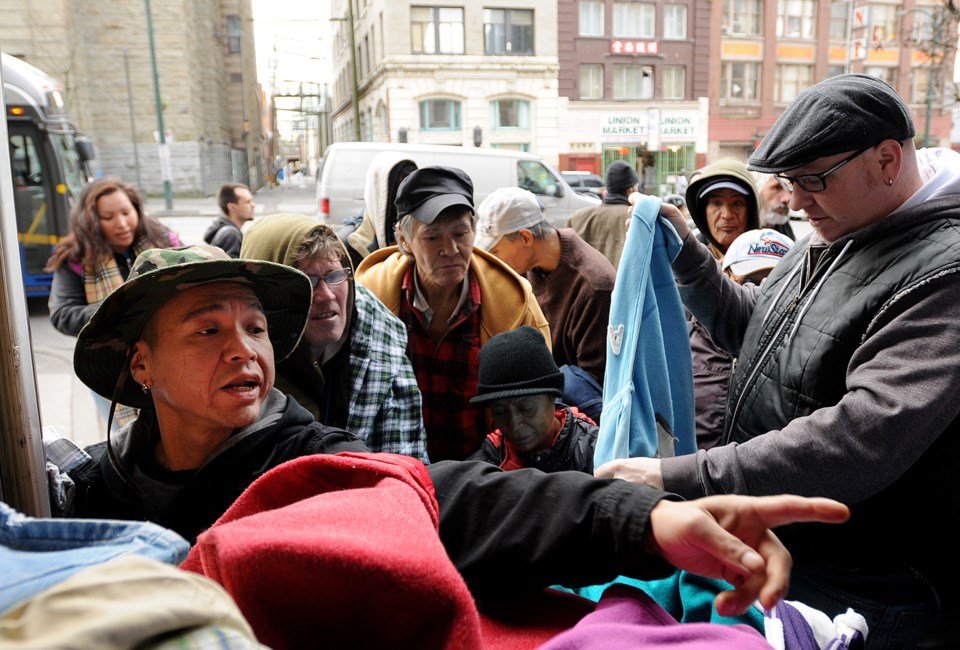The news, again, is not good for the city’s aboriginal community: 30 per cent of homeless people quizzed about their heritage in the City of Vancouver’s annual homeless count identified themselves as aboriginal.
The percentage, however, could be higher since 364 of the 1,600 homeless people counted by city workers and volunteers in March did not respond to a survey or information wasn’t available about their
background.
Of 1,236 people who reported their heritage during the count, 30 per cent, or 369, said they were aboriginal. It’s a statistic that Patrick Stewart, chairperson of the Aboriginal Homeless Steering Committee, said doesn’t reflect the true number of homeless aboriginal people in Vancouver.
“We’ve always maintained those counts are a slice in time and an undercount,” said Stewart, who is troubled by the fact two per cent of the city’s population is aboriginal but continue to comprise a significant percentage of the homeless.
City council heard last Tuesday that 480 formerly homeless people who resided in the city’s shelters moved in to permanent housing in the past five years. But city staff didn’t track what percentage of the 480 people were aboriginal.
“We’re going to certainly work towards doing more detailed information gathering in the future,” said Brenda Prosken, the city’s general manager of community services.
Over the past few years, the Courier has interviewed aboriginal tenants in new social housing buildings. Some of those tenants were formerly homeless and moved into the eight buildings that opened under an agreement involving the city, the provincial government and Streetohome Foundation.
Six more buildings are scheduled to open under the agreement. Stewart said he would expect homeless aboriginal people to get priority when the units become available. The statistics, he said, support his recommendation.
“If the homeless count says 30 per cent are aboriginal, then we should have access to 30 per cent of the units,” Stewart said.
The non-profit operators of the eight buildings “work to find the appropriate tenant mix for each building, taking into account the needs of the residents and the capacity of the non-profit to manage the operation,” according to B.C. Housing, in an email response to the Courier.
The City of Vancouver and B.C. Housing signed an agreement requiring 50 per cent of tenants in all 14 buildings to be from the street or shelters, 30 per cent from single-room occupancy hotels and 20 per cent considered low-income.
“The aboriginal population is reflected in that mix,” B.C. Housing said.
One of the city’s homeless shelters at 201 Central St. is operated by the Vancouver Aboriginal Friendship Centre Society.
It is located near the intersection of Main and Terminal and the majority of its 100 spaces are occupied by aboriginal people.
Susan Tatoosh, executive director of the Aboriginal Friendship Centre, said shelter staff connect tenants with various service agencies and housing providers. The goal is to address a tenant’s need —whether it be treatment for an addiction or finding employment — and place that person in housing linked to services.
“We have our network in place,” said Tatoosh, who urged the City of Vancouver to continue giving the aboriginal community a voice when planning and making decisions to eradicate homelessness.
“They should continue doing what they’re doing now which is much more than they were doing five years ago.”
The B.C. Health of the Homeless Survey authored by Dr. Michael Krausz in 2011 said aboriginal people face “unique challenges and have specific health care needs as a result of colonization and the residential school system. Many have been victims of abuse and neglect and many are vulnerable and exposed to high-risk environments.”
mhowell@vancourier.com



